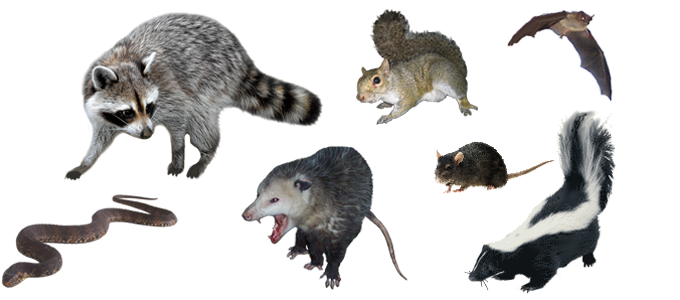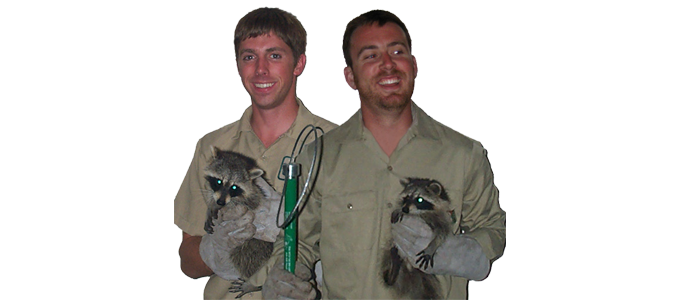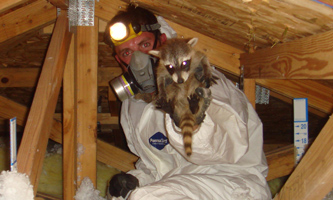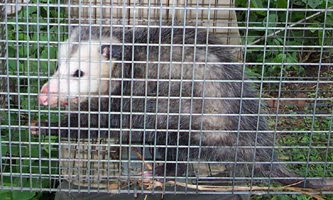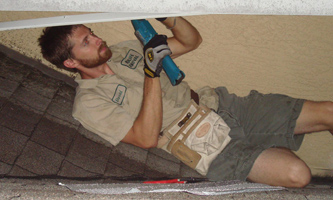San Bernardino Wildlife Control Services
We Provide a Full Range of California Wildlife Removal Services
What problems do wildlife cause?
Most of the calls we get are because homeowners hear animals scurrying around inside the attic or walls. Most of the damage inside a houes or attic is unseen. Rodents like squirrels, mice, and rats often chew on electrical wires.
Wildlife such as raccoons, bats, birds, opossums, and rats spread several diseases that humans can and do catch, such as Histoplasmosis, Salmonella, Leptospirosis and more. Many critters leave droppings and urine in an attic or cause mold or odor problems.
We also handle animals outside the house. It could be a critter that has dug a large hole next to your house, or a raccoon in your garbage cans, an opossum that is stealing pet food, or a skunk living under your deck, causing an odor problem. Some animals destroy your garden or landscaping. Or perhaps you are simply scared of snakes. Whatever
the problem is, our wildlife experts can remove the source of the problem, and prevent it from happening again. We are not a San Bernardino extermination company, nor pest control. We are dedicated San Bernardino wildlife control experts.
San Bernardino Raccoon Removal - Raccoons commonly live in the attic, where they cause damage. They can also cause many problems outside.
San Bernardino Rat Extermination - We solve rat and mouse problems PERMANENTLY, by finding and sealing shut any and all rat entry holes.
San Bernardino Bat Control - We have a 100% success rate safely removing California bats from buildings, and we guarantee our work.
San Bernardino Squirrel and Rodent Removal - For any critter, such as squirrels in the attic, we remove them, repair damage, & clean.

Why is our company the best?
We believe we are San Bernardino's best. We do a complete job, from start to finish. We remove wildlife humanely and effectively. When we encounter animals inside a house, we inspect every part of the house, from ground to roof, to identify all the areas of entry, and we perform professional repairs, with guarantee. We inspect inside the attic to find any damage, and provide full cleaning services. We offer attic restoration, permanent rodent control, bat colony exclusion, bird prevention, snake removal, dead animal removal and odor control, and more. We are fully California licensed and insured, and ready to solve your San Bernardino critter problem. Call us any time for a phone consulation and price quote, at 909-453-4908.
San Bernardino wildlife removal - article of the month
Colonizing bats- Appearance, Biology, Life cycle, Habitat, diet , behaviour and reproduction
Many animal activists believe that colonizing bats are unjustly treated because they possess some huge ecological values
whereas, bats have been known to cause some of the most significant damages to homes, because they move in huge numbers
and their colonies are extremely difficult to handle.
Behaviour
Bats are the only mammals that fly, they feed on blood and they are able to transmit various deadly diseases. As
bad as they may appear, bats have been found to help in controlling the activities of crops-destroying insects and
pests. There are over 900 species of colonizing bats in the world, while other San Bernardino bird control believe there are more than a thousand
of such , hence bats make up about 1/5th of the total mammal population in the world. Bats are nocturnal in nature- they
sleep during the day and are more awake in the night. Bats can fly for more than 50 kilometers just to find food , and they
normally sleep upside down during the day especially on trees and roof of San Bernardino raccoon removal buildings.
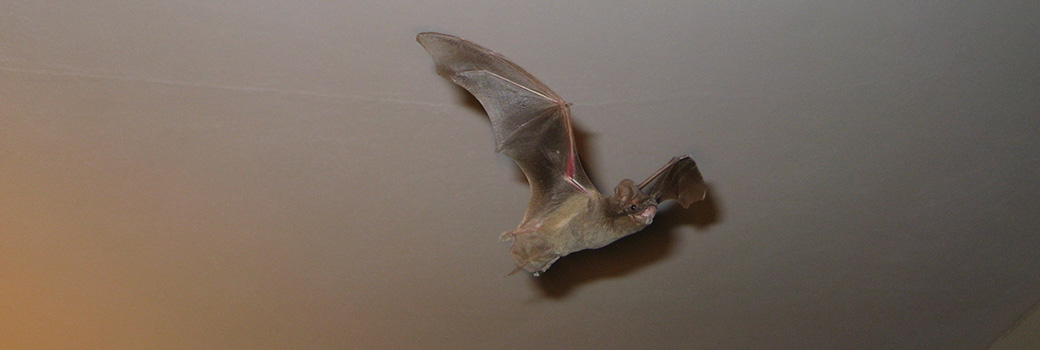
Appearance
Most colonizing bats are light brown in colour, however , their brown colour turns darker as they mature and age.
Biology
There are two main types of bats, The Micro or smaller bats and the mega-bats ( larger mammal bats). Bats generally belong
to the Chiroptera sub-order, and larger bats can weigh about 2.2 pounds and growing up to 1.8 meters in height and length.
Most colonial bats have light brown colour, with their fore arms extending by about 1.61 inches, and possess wingspan of about
11 inches. The foot of a typical colonial bat measures about 1cm. Bats belong to the animal kingdom- Animalia, and Mammalia class.
Lifespan
Most bats have wingspan of less than 1 meter and the smallest bat in the world is the “bumblebee” which weighs about 0.2 pounds.
Habitats
Colonial bats are often found in and around human San Bernardino snake removal residences all around the world, however some enjoy taking shelter around large
trees. The big brown bats and he night bats are the commonest species that cause significant damages in the roofs as well as some
other compartments of homes. The bat species that find nest in the tree or on the tree barks are not as destructive as those who
inhabit homes. Some species of bats such as red bats and keen bats only migrate at certain seasons of the year.
Bats have also been found in caves, barns and mines, they hide under any space that provide them shelter from predators, and
they live in groups of hundreds or thousands.
Diet
Bats have varieties of foods, and depending on the specie of bat, most bats will consume small insects, flowers, nectar, whole
fruits, leaves and pollens. While megabats eat fruits and some species even suck on blood, microbats consume insects. The Malayan
flying bat is one of the bat species with big appetite- it can consume foods as much as half of its entire body weight. Vampire bats
that suck on blood can eat foods twice their weight, and twice in a day. It is believed that the typical brown colonizing bat can eat
as many as 1,000 insects in one hour, while some bats like squeezing fruits and sucking their juices in their mouths.
The vampire-shape bats can suck blood from animals such as deer and cattle by making a V-shape cut on the skin of the animals and
licking their blood slowly. Most bats can catch San Bernardino rodent extermination insect and get them stuck through their thick saliva before swallowing them.
Reproduction
Colonizing bats have been found to possess certain San Bernardino rat control habits that are rarely found in other animals. In most cases, there are
usually separate hibernation sites for matured male and female bats, they swarm around in large numbers and perform special
acrobatics to attract each other. The sexually matured females often do most of the searching and the breeding pairs often
go to secluded spots where they mate in private. Mating in bats occur mostly in warm summer months, while the females store
male sperms until the next spring seasons. The gestation period in female bats is between 40 days and 6 months. Female bats
often give birth to a single pup bat at a time, and such a pup normally weighs about a fourth of the size of the mother and
just like other mammals, young pups rely on milk from their mothers to survive.
General behaviour
Unlike some other animals, most bats do not cause destruction to their nests, however, they can infest places with their
droppings and foods , and it is believed that bats can easily spread certain San Bernardino bat removal diseases when they bite or when humans or pets
come in contact with their droppings or urine. Bats may be difficult to detect in the day time because they are only active
in the night.
Other San Bernardino animal pest control topics:
Armadillo Prevention Tips
How to Trap a Skunk
How to get a Groundhog From Under a Shed
Information About Squirrels
I think we all can agree that nothing is worse than
pulling old boxes out of the garage or closet and finding
animal droppings! The best thing you can do is take pictures of it
so we can try to figure out what animal is living rent free in your
home. If you are cleaning the feces please take caution, and use
proper self protection against whate ever diseases may be around
due to the feces. Our team is one of the best when it comes to trapping,
removing, and finding the entry points to ensure other animals don't come
into your home. We answer our phones 24/7 to better service your San Bernardino
Wildlife needs! We service the following cities:
Adelanto, Apple Valley, Barstow
Chino, Chino Hills, Colton,
Fontana, Grand Terrace, Highland,
Loma Linda, Montclair,
Fontana,
Rialto,
Redlands,
Rancho Cucamonga,
Ontario,
Upland,
Victorville,
and Hesperia.
We also service the following counties:
Inyo County, Kern County, Los Angeles County,
Orange County, and Riverside County.
We are ready to solve your San Bernardino wildlife removal issue!
Call 24/7 to discuss your wildlife problem and get a price quote.
Call us any time at 909-453-4908 - We look forward to solving your wildlife problem!


